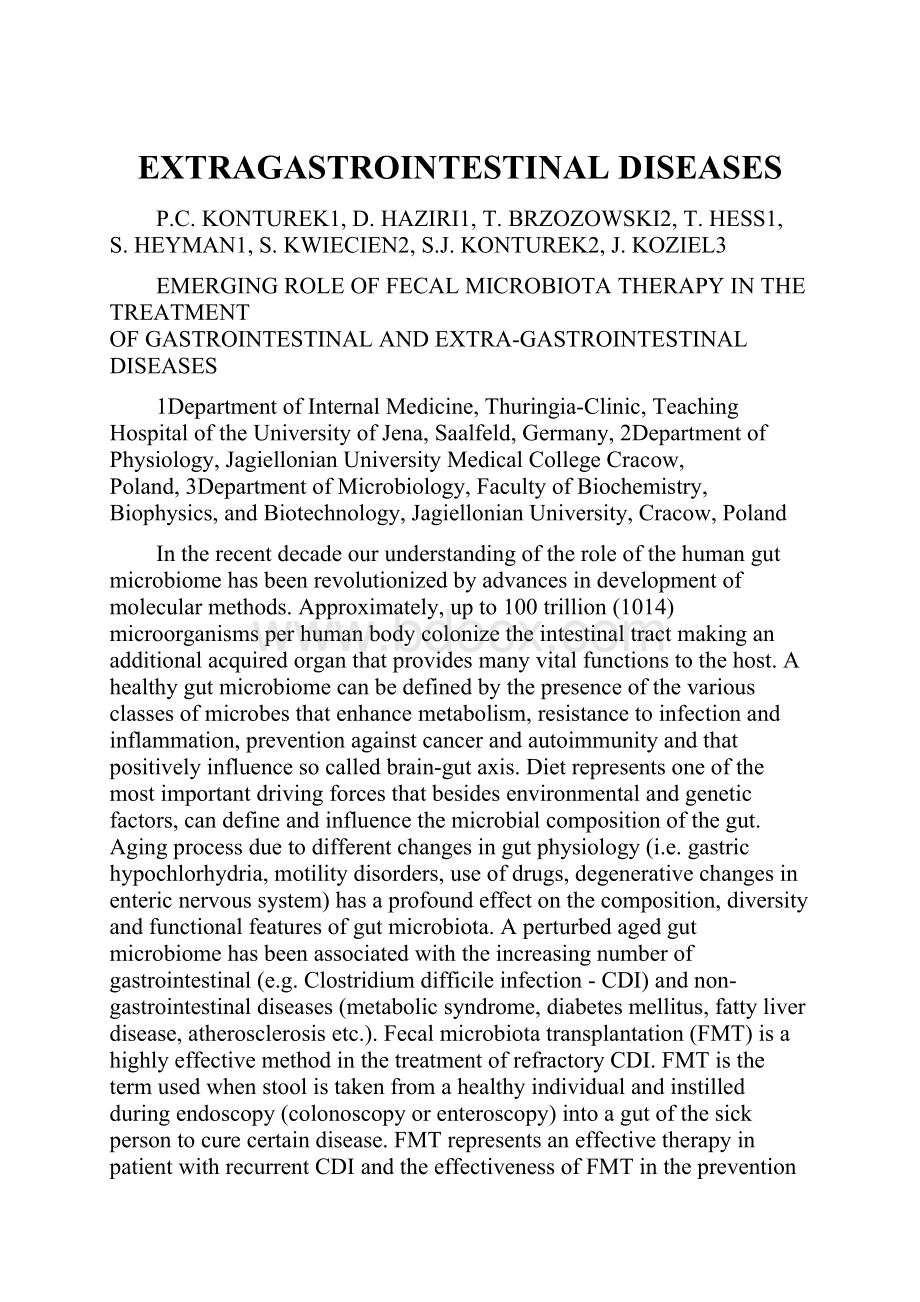EXTRAGASTROINTESTINAL DISEASES.docx
《EXTRAGASTROINTESTINAL DISEASES.docx》由会员分享,可在线阅读,更多相关《EXTRAGASTROINTESTINAL DISEASES.docx(22页珍藏版)》请在冰豆网上搜索。

EXTRAGASTROINTESTINALDISEASES
P.C.KONTUREK1,D.HAZIRI1,T.BRZOZOWSKI2,T.HESS1,
S.HEYMAN1,S.KWIECIEN2,S.J.KONTUREK2,J.KOZIEL3
EMERGINGROLEOFFECALMICROBIOTATHERAPYINTHETREATMENT
OFGASTROINTESTINALANDEXTRA-GASTROINTESTINALDISEASES
1DepartmentofInternalMedicine,Thuringia-Clinic,TeachingHospitaloftheUniversityofJena,Saalfeld,Germany, 2DepartmentofPhysiology,JagiellonianUniversityMedicalCollegeCracow,Poland, 3DepartmentofMicrobiology,FacultyofBiochemistry,Biophysics,andBiotechnology,JagiellonianUniversity,Cracow,Poland
Intherecentdecadeourunderstandingoftheroleofthehumangutmicrobiomehasbeenrevolutionizedbyadvancesindevelopmentofmolecularmethods.Approximately,upto100trillion(1014)microorganismsperhumanbodycolonizetheintestinaltractmakinganadditionalacquiredorganthatprovidesmanyvitalfunctionstothehost.Ahealthygutmicrobiomecanbedefinedbythepresenceofthevariousclassesofmicrobesthatenhancemetabolism,resistancetoinfectionandinflammation,preventionagainstcancerandautoimmunityandthatpositivelyinfluencesocalledbrain-gutaxis.Dietrepresentsoneofthemostimportantdrivingforcesthatbesidesenvironmentalandgeneticfactors,candefineandinfluencethemicrobialcompositionofthegut.Agingprocessduetodifferentchangesingutphysiology(i.e.gastrichypochlorhydria,motilitydisorders,useofdrugs,degenerativechangesinentericnervoussystem)hasaprofoundeffectonthecomposition,diversityandfunctionalfeaturesofgutmicrobiota.Aperturbedagedgutmicrobiomehasbeenassociatedwiththeincreasingnumberofgastrointestinal(e.g. Clostridiumdifficile infection-CDI)andnon-gastrointestinaldiseases(metabolicsyndrome, diabetesmellitus,fattyliverdisease,atherosclerosisetc.).Fecalmicrobiotatransplantation(FMT)isahighlyeffectivemethodinthetreatmentofrefractoryCDI.FMTisthetermusedwhenstoolistakenfromahealthyindividualandinstilledduringendoscopy(colonoscopyorenteroscopy)intoagutofthesickpersontocurecertaindisease.FMTrepresentsaneffectivetherapyinpatientwithrecurrentCDIandtheeffectivenessofFMTinthepreventionofCDIrecurrencehadreachedapprox.90%.ThereisalsoanincreasingevidencethatthemanipulationofgutmicrobiotabyFMTrepresentsapromisingtherapeuticmethodinpatientswithinflammatoryboweldiseaseandirritablebowelsyndrome.ThereisalsoanincreasedinterestintheroleofFMTforthetreatmentofmetabolicsyndromeandobesitywhichcollectivelypresentthegreatesthealthchallengeinthedevelopedworldnowadays.TargetingofgutmicrobiotabyFMTrepresentsanexcitingnewfrontierinthepreventionandmanagementofgastrointestinalandnon-gastrointestinaldiseasesthatawaitsfurtherstudiesinpreclinicalandclinicalsettings.
Keywords:
gutmicrobiota,fecalmicrobiotatransplantation,brain-gutaxis,inflammatoryboweldisease,Clostridiumdifficile,irritablebowelsyndrome,functionalgastrointestinaldisorders
IMPORTANCEOFGUTMICROBIOTA
AccordingtothefamouswordsofHippocrates,hisstatementthat“alldiseasebeginsinthegut”seemstobeofgreatimportancenowadays.Withthesewordsthefatherofthemodernmedicinesuggestedtheessentialroleplayedbygutanddietinmanyvitalhomeostaticfunctionsofthehumanbody
(1).Intherecentdecadeourunderstandingoftheroleofthehumangutmicrobiomehasbeenrevolutionizedbyenormousadvancesindevelopmentofmolecularmethods(especiallyhighthroughputDNAsequencing).Basedonthisknowledge,thegutmicrobiomeisconcernedasthemostdenselypopulatedanddiversemicrobialcommunities
(2).Approximately,morethan500differentmicrobialspeciesconstitutingupto100trillion(1014)microorganismsperhumanthatcancolonizetheintestinaltractmakinganadditionalacquiredorganweighingca.1.5–2kg(Fig.1).Thehumangutmicrobiotaisremarkablydiverse.Thecolonizationofgutbymicrobesbeginsafterdeliveryandthebabyearlylifeenvironmentplaysacrucialroleinthedevelopmentofhealthymicrobiome.Oncefullydeveloped,gutmicrobiomebecomestheessentialacquiredorganthatprovidesmanyvitalfunctionstothehost.Currentlyithasbeensuggestedthat4differentPhyla(Bacteroidetes,Actinobacteria,Firmicutes andProteobacteria)consistingofthousandsofmostlyanaerobicspeciesinhabitthehumangutwithasteep,stomachacid-drivenproximal-distalgradient(Fig.1).Thenumberofgenesinmicrobiotaoutnumberhumangenesbyonehundredfold(3).Thegeneralhumanpopulationcanbestratifiedonthesolebasisofthreedominantbacteria(i.e.theconceptofenterotypes),orsubjectscategorizationaccordingtotheirmicrobiomegenerichness.Bothaspectshavebeenstrengthenedbyrecentstudiesinvestigatingtheimpactofnutrients(e.g.,dietaryfibers,fatfeeding)anddietaryhabits(i.e.,vegansversus omnivores)ofdifferentpopulations(4).
Fig.1. Spatialandlongitudinalvariationsinmicrobialnumbersandcompositionacrossthelengthofthegastrointestinaltract.Thehumanmicrobiotacontainsasmanyas1014 bacterialcells,whosenumberthatis10timesgreaterthanthenumberofhumancellspresentinthebodies.Thenumberofbacterialcellspresentinthemammaliangutshowsacontinuumthatgoesfrom102 to103 bacteriapergramofcontentsinthestomachandduodenum,progressingto104 to107 bacteriapergraminthejejunumandileumandculminatingin109 to1012 cellspergraminthecolon.
Fromtheclinicalpointofviewthemostofthemicrobialspeciescanbedetectedbycultureindependentmethodssuchas16sribosomalRNAsequencingmethod.Importantly,eachindividualhasitsownuniquemicrobiota,sothegutmicrobiomeofeachindividualislikeafingerprint.Thecompositionofthegutmicrobiotaremainsrelativelystablefromlatechildhoodtooldage,whenchangesoccuragainduetoagingprocess(5,6).Morerecently,groupsofbacterialfamilieshavebeenclassifiedintoenterotypesonthebasisoftheirfunctions.Thisclassificationisbasedonmetabolismofdietarycomponentsandabilitytotolerateandmetabolizedrugswhichshouldhelptofurtherunderstandingoftheroleofentericmicrobiotainhealthanddisease.Agingisassociatedwithchangesindiversityofnon-culturedspecies,withagreaterproportionof Bacteroides species,adistinctabundanceof Clostridiumclusters,anincreasedenterobacteriapopulation,andalowernumberofBifidobacteria (7,8).
Thehumanbeingslifestyle,dietandmedicalinterventionsincludingpharmacologicaltherapyincludinguseofantibioticsandprotonpumpinhibitorshaveprofoundimpactonthecomposition(diversity)ofthegutmicrobiota(9).Theimpairmentofhomeostasisbydysbiosismayincreasesusceptibilitytoinflammatoryboweldiseases(IBD)(9).Theenvironment,genetics,andhostimmunityformahighlyinteractiveregulatorytriadthathavebeenshowntoregulatetolllikereceptor(TLR)function.ImbalancedrelationshipswithinthistriadmaypromoteaberrantTLRsignaling,criticallycontributingtoformationofinflammasomeresultinginacuteandchronicintestinalinflammatoryprocesses,suchasinIBDconsistingofCrohndiseaseandulcerativecolitis,andcolorectalcancer(10).Inparticular,IBDarecharacterizedbyidiopathicintestinalinflammationthatcanarisefrompredisposinggenetic(genesencodingproteinsrelevanttobothinnateandadaptiveimmunity:
NOD2,STAT3,IL-23receptor,etc.)andenvironmentalfactors(specificTLRsligands,andantigensderivedfromcommensalbacteria)actingontheimmunoregulatorysystem.ItisgenerallyacceptedthatIBDmayberesultofanimbalanceofproinflammatory-andregulatory-T-cellsresponses(11,12).
The“lasthumanorgan“playsacentralroleinthedevelopmentofimmunesystem,alterationsinintestinalfunctionsanddefenseagainstpathogensandmetabolism(13)(Fig.2).Beyondthemicrobialrichness(diversity),ahealthygutmicrobiomeischaracterizedbythepresenceofthemicrobesthatenhancemetabolism,resiliencetoinfectionandinflammation,resistancetocancerandautoimmunityandthepositiveinfluenceonbrain-gutaxis(14,15).Importantly,thegutmicrobiotaaffectstheintestinalmucosa via interactionwithepithelialcells,entericnervoussystemleadingtochangesingutmotility,sensoryfunctionsandpainperception(microbiota-brain-gutaxis)(16)(Fig.2).Microbiota-braininteractionsconstituteanexcitingareaofresearchwhichmaycontributetothenewinsightsintoindividualpredispositionsincognition,personality,mood,sleep,andeatingbehavior(17).Moreover,thisinteractioncanhelpinunderstandingofawiderangeofneuropsychiatricdiseasesrangingfromaffectivedisorderstoautism,depressionandschizophrenia(Fig.2).Gutmicrobesaffectthefunctionsofintestinalbarrier,especiallyitspermeabilityaswellascellproliferationandproductionofIgAanddefensins(18).
Fig.2. Physiologicroleofgutmicrobiotainfluencedbydiet:
thebidirectionaleffectofgutmicrobiotaonthebrain-gutaxis,defenseagainstpathogens,effectonmetabolism via microbiota-liveraxisandalterationsofintestinalfunctionsincludinganimpactonintestinalpermeability,sensoryandmotilityfunctions.
Themechanismbywhichmicrobiotamaycontributetothefunctionofbrain-gutaxisremainsunknownbutmicrobesreleasemanybiologicallyactivesubstancessuchasentericshortchainfattyacids(SCFA)thatshowstrongimmunomodulatoryandsensoryeffects.AmongtheSCFAs,theaceticacid(AA),butyricacid(BA),andpropionicacid(PPA)arethemostaboundant(19).TheSCFAsconsistofthemajorclassofsignalingmoleculesproducedfrombacterialfermentationo